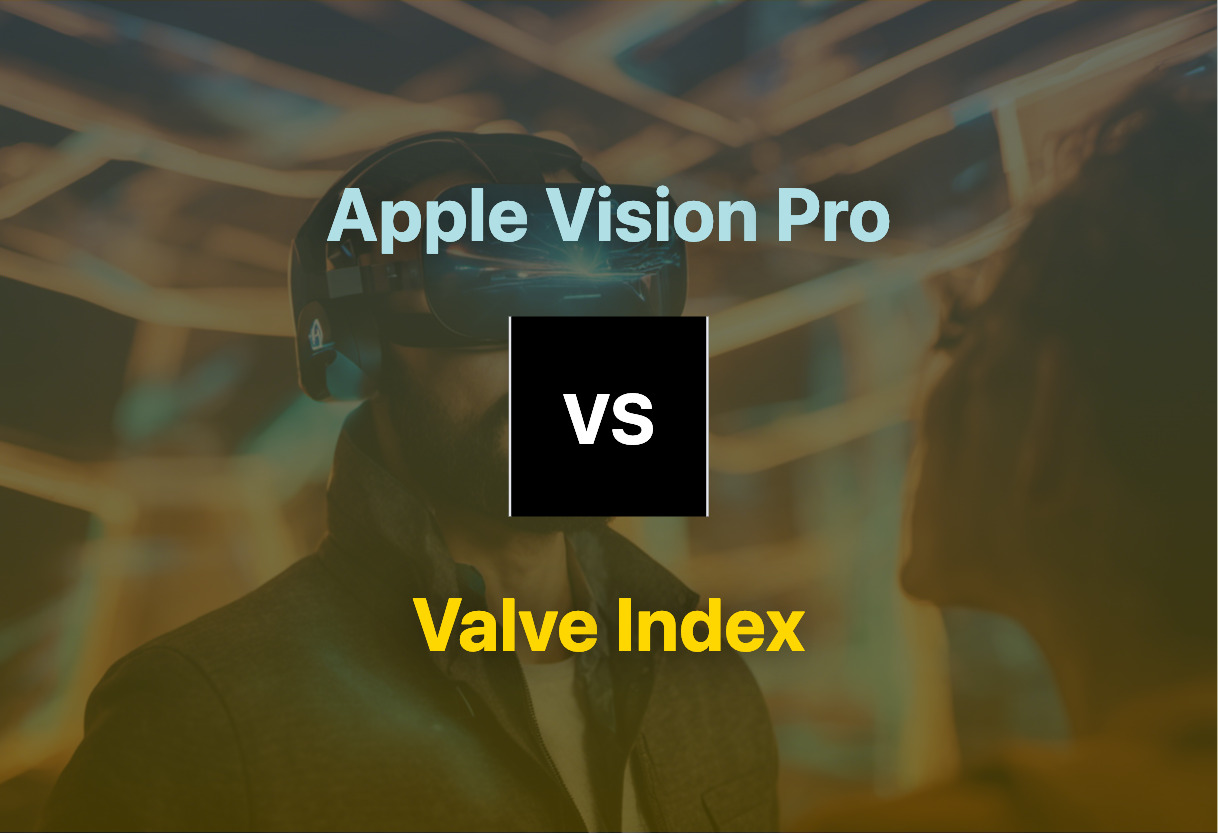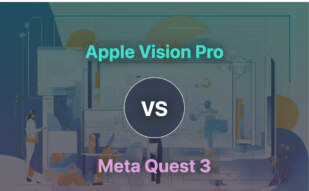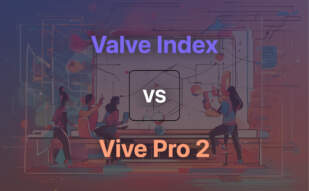For high-grade engagement, Apple Vision Pro wins with features like advanced facial realism and environment transformation. However, Valve Index offers a more affordable VR solution, with superior FOV and off-ear audio. For immersive AR, choose Apple. For cost-effective VR, Valve is your champion.

Key Differences Between Apple Vision Pro and Valve Index
- Operating Systems: Apple Vision Pro runs on VisionOS whereas Valve Index operates on Windows and Linux.
- Affordability: Valve Index, priced at $799, is more economical than Apple Vision Pro, starting at $3,499.
- Display: Apple Vision Pro’s micro-OLED provides superior resolution than Valve Index’s RGB LCDs.
- Interactivity: Apple Vision Pro offers eye, voice, and hand controls; Valve Index primarily uses hand controllers.
- Compatibility: Valve Index maintains compatibility with HTC Vive and Vive Pro Controllers; Apple Vision Pro works with iPhone, iPad, and Mac devices.
- Field of View: Valve Index delivers a wider FOV compared to Apple.
- Augmented vs Virtual Reality: Apple Vision Pro blends physical and digital spaces whereas Valve Index offers a pure, immersive VR experience.
| Comparison | Apple Vision Pro | Valve Index |
|---|---|---|
| Technologies | Mixed Reality | Virtual Reality |
| Control Methods | Voice, Eyes, Hands | 87 Sensor Controllers |
| Immersive Entertainment | Yes | Yes |
| Compatible OS | macOS, iOS, iPadOS | Windows, Linux |
| Release Date | 2024 | June 28, 2019 |
| Starting Price | $3,499 | $999 |
| Battery Life | 2 hours (external, wearable battery) | Dependent on connected device |
| Performance | Dual-Chip Processor (Apple M2 and R1) | Varies with connected device |
| Developer Support | Vision Pro Developer Kits | In-house development by Valve |
What Is Apple Vision Pro and Who’s It For?
With Apple Vision Pro, the tech heavyweight Apple leaps into the realm of mixed reality. The device, which projects digital content onto physical spaces, is an innovative experience blending technology and reality. It’s ideal for tech enthusiasts, professionals seeking immersive and collaborative tools, and anyone yearning for next-level entertainment and social connection.
Your physical space is your new computing platform, thanks to an ‘infinite canvas’ for apps, 3D-messaging, and life-size Facetime features. Content creators, this is your new playground.

Pros of Apple Vision Pro
- Packs powerful spatial experiences with VisionOS
- Compact, sleek design with advanced technology.
- Promotes social connectivity through immersive FaceTime features
- Secure authentication with unique iris patterns via Optic ID
- High-performance dual-chip design
Cons of Apple Vision Pro
- Steep pricing starting at $3,499
- External wearable battery with a short 2-hour lifespan
- Set to be released in 2024, making it a future investment
- Needs peripheral devices to fully utilize features
What Is Valve Index and Who’s It For?
The Valve Index is a second-generation virtual reality headset from a gaming industry giant, Valve. Released in June 2019, it offers a sophisticated, immersive gaming experience for serious PC gamers and VR enthusiasts.
With its enhanced displays for sharpness, varied frame rates for comfort, advanced audio solutions, and intuitive controllers, it’s a strong contender in the VR market. Perfect for those focused on higher-quality, comfortable, and immersive gaming experiences.

Pros of Valve Index
- Enhanced displays and field of view
- Comfort-focused design with adjustable settings for user-customization
- Advanced off-ear audio solution
- Extended compatibility with other VR devices and platforms like Steam
Cons of Valve Index
- Expensive, with prices starting at $799 for headset only
- Device lacks eye-tracking technology
- The setup can be frustrating, especially for room-scale sensor setup
- Supply was limited upon its release due to COVID-related production issues
Apple Vision Pro vs Valve Index: Pricing
The introductory price for Apple Vision Pro is $3,499, making it significantly costlier than the Valve Index, which was initially priced at $999 and subsequently reduced to $799 for the headset only.
Apple Vision Pro
Promising a premier mixed reality experience, Apple Vision Pro is priced at $3,499, scheduled to hit the market in early 2024. A prime feature is its compatibility with iPhone, iPad apps, and Mac integration for a broad application scope. An underpinning attraction is its recognition of unique iris patterns by Optic ID for secure authentication. However, the substantial price does pose a barrier for many potential consumers.
Valve Index
The Valve Index, a second-generation consumer virtual reality headset developed in-house at Valve, made its debut costing $999. Currently, the headset alone retails at $799. The full set, composed of the Index headset, controllers, and two base stations, retains its original price of $999. Although less pricey than the Apple Vision Pro, it’s still considered a high-end purchase in the VR space.
Apple Vision Pro vs Valve Index: The Final Call
The crux lies in their technology intent. The Apple Vision Pro excels as an AR blend of the digital and physical world, while Valve Index provides a quintessential VR experience. Let’s skim through distinct audience preferences:
Technological Virtuosos
The Apple Vision Pro’s premiere mixed-reality with advanced spatial facilities, superior to 4K displays, and handy integration with macOS, iOS, and iPadOS becomes a melting pot of technological superiority. In contrast, Valve Index with its robust VR technology, fine-tuned FOV, and 144Hz refresh rate, appeals to hardcore gamers and VR enthusiasts.

Secure Enthusiasts
For individuals mindful of their privacy, Apple Vision Pro trumps with its unique Optic ID that uses iris patterns for secure authentication. Valve Index lags without a distinct privacy feature.

Expressive Multimedia Artists
Apple Vision Pro‘s 12-camera setup for 3D content creation wins over Valve Index’s unavailability of such features. Expressive artists and videographers might gravitate towards Apple’s offering.

Dedicated Developers
The Valve Index’s compatibility with Steam, its hardware-agnostic nature, and Linux support stand out to developers who look forward to unrestricted creativity. Apple Vision Pro’s developer kits, though, may draw those aligned with Apple’s ecosystems.

The choice between Apple Vision Pro and Valve Index hinges on user preference for mixed-reality or VR immersion, privacy importance, multimedia usage, and ecosystem alignment. Choose vision; choose your reality.
Grant Sullivan
Content writer @ Aircada and self proclaimed board game strategist by day, AI developer by night.





